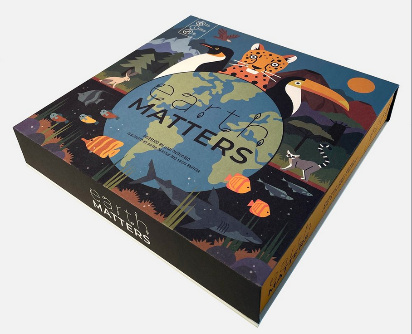Engaging Young Minds: A Board Game Approach to Climate Education
In the quest to make complex topics like climate change accessible to children, a former art teacher has ingeniously developed a board game called “Earth Matters.” Designed for 2–5 players, the game creatively sparks discussions among children about the causes, effects, and potential solutions to the climate crisis.

The central feature of the game is its board, which resembles a giant graph with time plotted on the x-axis and temperature on the y-axis. Scattered across this graph are habitats and energy resources that players interact with to gain points. Beginning with the selection of animal pawns and starting positions, players navigate forward in time and alter temperatures by moving across the board. This interactive approach doubles as a fun way to teach children about graphing.
The gameplay is driven by a unique deck of cards that dictate actions. Players might share eco-friendly practices, learn fascinating facts about nature, or encounter significant events. Positive environmental actions, such as installing solar panels, reward players with points, while harmful activities, like burning fossil fuels, result in point penalties or increased temperature.
The game is best suited for children aged 6–10, offering a balance of entertainment and education. During a play session with her 12-year-old daughter, one player found the game too simplistic for older children. Her daughter easily tackled most questions, although some cards seemed too juvenile, such as one that humorously instructed her to “Howl like a wolf!”
Middle schoolers, known for their critical thinking, might find certain inconsistencies within the game. For instance, a card penalizing sugary drink consumption puzzled the daughter, who remarked, “That isn’t fair. That doesn’t have anything to do with the environment.” Concerns also arose over whether such cards could be misinterpreted as pushing a political agenda, though this was an isolated case.
Additional game scenarios prompted reflection. One card stated, “Five islands in the Solomon Island chain are underwater. The hottest player may cool down three degrees,” which confused the daughter. She questioned why a negative climate impact would have a positive effect on the player’s status. A similar observation was made about the high-point value of fossil fuel energy tokens, which seemed counterintuitive given their environmental impact. However, their placement near the top of the board aligns with higher temperatures and increased extinction risk, offering a nuanced perspective.
Despite these challenges, the game facilitates teachable moments. For instance, a card about voting sparked a discussion about the link between political choices and environmental policies, highlighting the importance of civic engagement in addressing climate change. Moments like these provide educational opportunities that parents and educators can leverage to deepen children’s understanding.
“Earth Matters” stands out for its durability, attractive artwork, and the use of small shells and rocks as game pieces. While it surpasses many educational games for the same age group, it is most effective when played with an adult who can guide conversations. Without predetermined answers, the game encourages dialogue about technology, personal choices, and collective actions, making it an excellent tool for fostering meaningful discussions about the environment with young learners.
Original Story at ncse.ngo
![Earth Matters Engaging Kids in Climate Change with a Fun - Creation Covenant Alliance [Review] "Earth Matters" | National Center for Science Education](https://creationcovenantalliance.org/wp-content/uploads/2025/01/Earth-Matters-Engaging-Kids-in-Climate-Change-with-a-Fun.png)